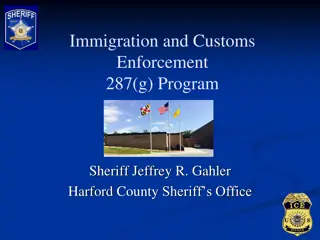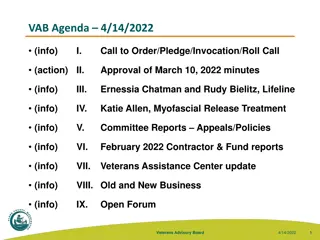Clark County Safety Management Program Overview
The Clark County Safety Management Program aims to improve traffic safety through data-driven approaches, prioritizing projects for maximum impact and cost-effectiveness. By analyzing crash data and roadway characteristics, the program identifies high-priority locations for safety improvements, developing projects to enhance safety measures while optimizing county funding utilization. The framework includes network screening, project development, and ranking processes based on AASHTO Highway Safety Manual guidelines.
Download Presentation

Please find below an Image/Link to download the presentation.
The content on the website is provided AS IS for your information and personal use only. It may not be sold, licensed, or shared on other websites without obtaining consent from the author.If you encounter any issues during the download, it is possible that the publisher has removed the file from their server.
You are allowed to download the files provided on this website for personal or commercial use, subject to the condition that they are used lawfully. All files are the property of their respective owners.
The content on the website is provided AS IS for your information and personal use only. It may not be sold, licensed, or shared on other websites without obtaining consent from the author.
E N D
Presentation Transcript
Clark County, WA Safety Management Program Western District ITE Monterey, CA June 23rd, 2019
Agenda Background Goals Safety Management Program Systemic Safety Improvement Program 8/9/17 2
Background Historically County had used traditional method of managing traffic safety Vision of a reliable and defensible technique to screen and prioritize projects Traditional methodology dealt with absolutes in terms of safety improvements Highway Safety Manual can provide quantitative value for nominal safety improvements resulting in estimates for benefit cost ratio 8/9/17 3
Goals The Clark County Safety Program was established with the following goals: Better identify locations for potential safety improvement projects Use an objective data-driven process to prioritize locations throughout the County Develop projects for high priority locations Quantify and compare the benefit-cost ratio of any potential improvements OVERALL: Best use of County Funding 8/9/17 4
Safety Program Data driven Screening based on reported crashes Range of improvement options at one specific site Safety Management Data driven Risk factors identified with reported crashes and roadway characteristics Focused on low cost improvements at various sites Systemic Safety 8/9/17 5
Data Due Diligence Data located in County s GIS database: Crash data Date Severity Crash type Roadway inventory data County road log number and mileposts Functional classification Traffic volume data (ADT) Posted speed (miles per hour) 8/9/17 6
Safety Management Program Framework 1) Network Screening 2) Project Development 3) Project Ranking Split into reference populations Run analysis to calculate performance measures used for ranking Identify top 5% safety need locations Identify top 15 intersections and segments Crash diagrams and site visit Identify Contributing Factors Identify Potential Countermeasures Calculate project costs Estimate benefits over design life Rank by benefit-cost ratio Based on the AASHTO Highway Safety Manual s (HSM) Roadway Safety Management Process. 8/9/17 7
Network Screening Process A) Establish Reference Populations Identify distinct roadway characteristics Group sites (segments or intersections) with similar roadway characteristics into subsets of County Establish number of populations for network screening C) Select Performance Measures Measures reflect Priority Areas Establishes methodology for ranking sites B) Establish Priority Areas D) Screen Network Conduct crash analysis to identify over-represented crash types List of safety priority areas Apply performance measures Identify sites that exceed performance measure(s) Rank sites within reference populations 8/9/17 8
Network Screening Reference Populations 8/9/17 10
Network Screening Performance Measures 1. Crash-Critical Crash Rate Ratio 2. Frequency of Fatal and Severe Injuries 3. Excess Proportion of Specific Crash Type 4. Annual Equivalent Property Damage Only Score Performance measures were selected to account for crash severity, frequency, and types. 8/9/17 11
Network Screening Excess Proportion Crash Types Intersection Segment Angle Angle* Opposite Direction Opposite Direction* Fixed Object Fixed Object* Bicycle or Pedestrian Bicycle or Pedestrian Alcohol Impaired Alcohol Impaired *Primary Crash Type 8/9/17 12
Network Screening Performance Measures Performance Measure Description Maximum Scoring Crash-Critical Crash Rate Ratio Compares crash frequency normalized by ADT to similar facilities 1.0 Frequency of Fatal or Severe Injuries Accounts for presence of a fatal or Injury A crash (and quantity) 1.5 Excess Proportion of Specific Crash Type Identifies locations where the proportion of a specific crash type exceeds the average for similar sites 1.5 Annual Equivalent Property Damage Only Score Assigns weight based on frequency of crashes by severity level 1.0 Maximum total score of 5.0 8/9/17 13
Project Development and Ranking Process Select Sites from Network Screening Results Evaluate Project Benefit/Cost and Rank Projects Diagnose and Select Countermeasures 8/9/17 14
Priority Locations Top 5% of locations from network screening 180 intersections 400 segments Evaluate top sites based on recent context: Remove locations where improvements are already identified Remove locations that may be impacted by other construction 8/9/17 15
Site Reviews Field visits at priority intersections and corridors Includes the following items: Review crash trends to identify potential problems at the site (collision reports) Observe traffic operations Measure sight distances, as needed Drive approaches or corridors to evaluate from users perspective 8/9/17 16
Crash Prediction Long-Term Expected Average Number of Crashes minimizes influence of the randomness of crashes 20 16 Crashes 12 8 4 0 0 5 10 15 Years Crashes Average 8/9/17 17
Project Packages and Benefit/Cost Two tiers: near-term and long-term project packages Tier I Lower cost, higher ease of implementation New signs and striping Signal timing and phasing changes Shoulder rumble strips Tier II Higher cost, lower ease of implementation Intersection lighting Adding turn lanes Widening shoulders Guardrails 8/9/17 18
Project Packages and Benefit/Cost 8/9/17 19
Intersection Prospectus Sheet 8/9/17 20
Segment Prospectus Sheet 8/9/17 21
Systemic Safety Improvement Program Provides low cost safety countermeasures that can be applied at various locations with the same risk factors Toolbox of treatments for County s most prevalent risk factors: Rural road curves and grades on high-speed roadways Rural road fixed objects, including trees, stumps, posts, poles, embankments, or ledges Rural two-way stop controlled intersections Urban signalized intersections Pedestrian crossings on multi-lane urban roadways 8/9/17 22
Top Locations for Consideration Rural Curves Rural Two-Way Stop-Controlled Intersection Corridors NE Lucia Falls Rd between NE 172nd Ave and NE Sunset Falls Rd NW 199th St between 41st Ave and NE 29th St NE 119th St between NE 119th St and NE 172nd Ave Intersections created by NE 82nd St, NE 259th St, NE 72nd St, and NE Manley Rd NE Risto Rd between NE 207th Ave and NE 227th Ave NE 182nd St between NE Risto Rd and NE 119th St Rural Slopes SE Blair Rd between SE Washougal River Rd and WA-500 NE WH Garner Rd to NE Kelly Rd, continuing to NE Yacolt Mountain Rd Signalized Intersections NE Sunset Fall Rd between NE Deer Rd and NE Lucia Falls Rd NE 99th St and NE HWY 99 NE 78th St and NE HWY 99 Rawson Rd between NE 271st Ave and NE 139th St NE St Johns Rd and NE 78th St Rural Fixed Objects NE Covington Rd and NE 76th St NE Lucia Falls between NE 172nd Ave and NE Sunset Falls Rd Pedestrian Corridor NE 99th St between NE Hazel Dell Ave and NE 25th St Washougal River Rd between County Line and SE 17th St NE 78th St between NE Hazel Dell Ave and NE St Johns Rd Connection between NE 27th Ave at NE Blair Rd and NE 39th St at NE 292nd Ave NE HWY 99 between Minnehaha St and NE 104th St 8/9/17 23
8/9/17 24
8/9/17 25
Questions Ejaz Khan, P.E. Clark County, Washington Ejaz.Khan@clark.wa.gov Courtney Furman, P.E. Clark County, Washington Courtney.Furman@clark.wa.gov 8/9/17 26























